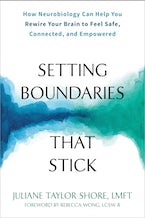By Juliane Taylor Shore, LMFT, author of Setting Boundaries That Stick
We have all heard the advice: taking things less personally will bring more internal peace. You get reactive in sticky communication with folks you care about, so just stop taking things so personally. Of course, those folks might be onto something, but how do you do that?
Also, you are a kind person. You do not want to turn into an unfeeling, cold, walled-off person. Is it possible to take things less personally and also stay connected and kind with folks around you? Yes, but you are going to need to start working with your brain in a new way to get there.
Your brain scans for potential physical and emotional danger four times per second. If your brain detects something that could be dangerous or stressful, then it calls on earlier learning about how you got through similar situations in the past. This is what is happening inside when people say you are being “reactive.” This happens fast, so none of this is going to feel like a thought or conscious decision. You can call up a recent time when someone said something that hit you in a hurtful way. Did you pause and think: what did they mean, was that meant to be hurtful, were they trying to insult me? Of course not. It hit your heart and then you did the thing you do next. Some of us yell, some of us wall off, some of us placate or people-please or fawn. Whatever you do, I promise it makes sense. That behavior worked for you at some point in the past. Yes, even if it comes with a big cost or makes no sense to you now.
If you are going to stop taking things personally, you are going to need to add some protection between you and the other person. That added protection will have the four-times-per-second scan detect threat less frequently because you are not in threat—you are protected enough.
That brings us to the mentalization neural network. This is a system in your brain that makes guesses about what is happening in the minds of other people. If that network (which has super-speedy processing) can know that protection between you and other people’s thoughts and feelings is real, then those heart and belly punches that come when:
· others think something about you that you know is a misunderstanding;
· others are feeling unpleasant feelings toward you;
· you share news that disappoints someone;
will soften a ton.
The only thing is that the mentalization neural network listens to your belly and heart area, and speaks in image or gesture. So, if you want to embed the sense of protection in that fast-processing mentalization neural network, then you will have to listen to your center and work with an image or small gesture.
I love that the brain changes with practice. You can use that fact to support you as you use this simple practice. Try on this thought: “When that person is communicating to me about me, they are mostly talking about themselves and letting me know a ton about what is happening with them. We do not have to agree for me to care about them.” Does that feel even a little bit plausible to you? If so, then ask yourself something a little strange: “Can you show me an image that can remind me it’s a lot about them, not me?”
Once you have your image, check it out by thinking back to a moment in which you took something personally, then relive that moment a bit in your mind, but this time float that image between you and another person. What happened?
If that moment feels a little less bad and you still feel kind and respectful toward the other person, then that image is going to serve you well for now (it might transform later) so go ahead and start practicing. Float that image between you and the world as often as you can remember to do it, and in about three weeks you will have honed a brand-new neural network that knows that it’s okay not to take it all in personally.
If you are one of the many who tries this and no image comes, or the thing doesn’t work as well as you are hoping, I have two thoughts for you that I hope you will take in. One: there is nothing wrong with you. And two: that’s a great indication that this is hard because somewhere along the way you were taught to take things very personally and maybe even take care of others’ feelings rather than gently connect to their feelings. This could mean that taking a deeper dive into inner boundary work (which is what we have been doing here) will support you best, and your image will come to you as you are ready.
No matter where you are in your journey, inner boundary work is tough. Be patient and kind with yourself as you support your growth.
Juliane Taylor Shore, LMFT, is a clinician, storyteller, and teacher of interpersonal neurobiology who lives with her husband, daughter, and dog in the hill country on the outskirts of Austin, TX. Shore specializes in trauma recovery and relational healing for individual adults and romantic partnerships, and also spends much of her time teaching therapists internationally. When she is not working, she is usually playing with her family, reading poetry, and making random art projects for fun.



 2024 Peace Playbook: 3 Tactics to Avoid Clashes with Your Partner
2024 Peace Playbook: 3 Tactics to Avoid Clashes with Your Partner